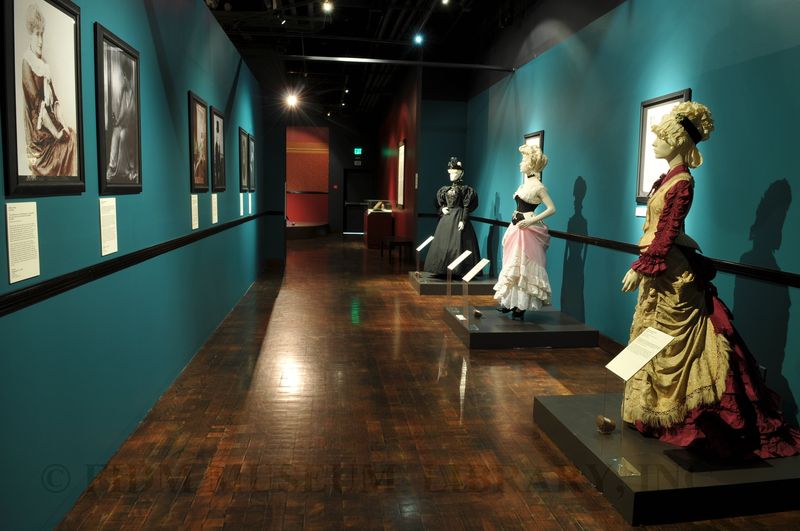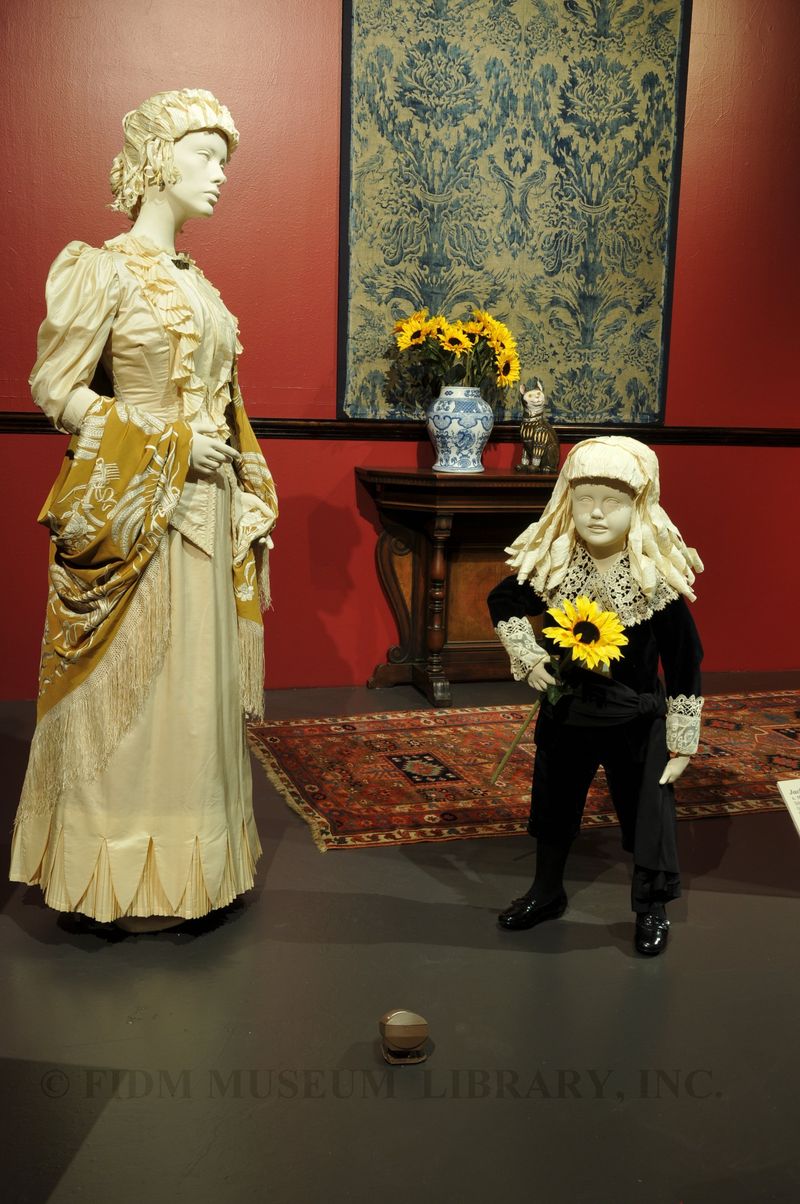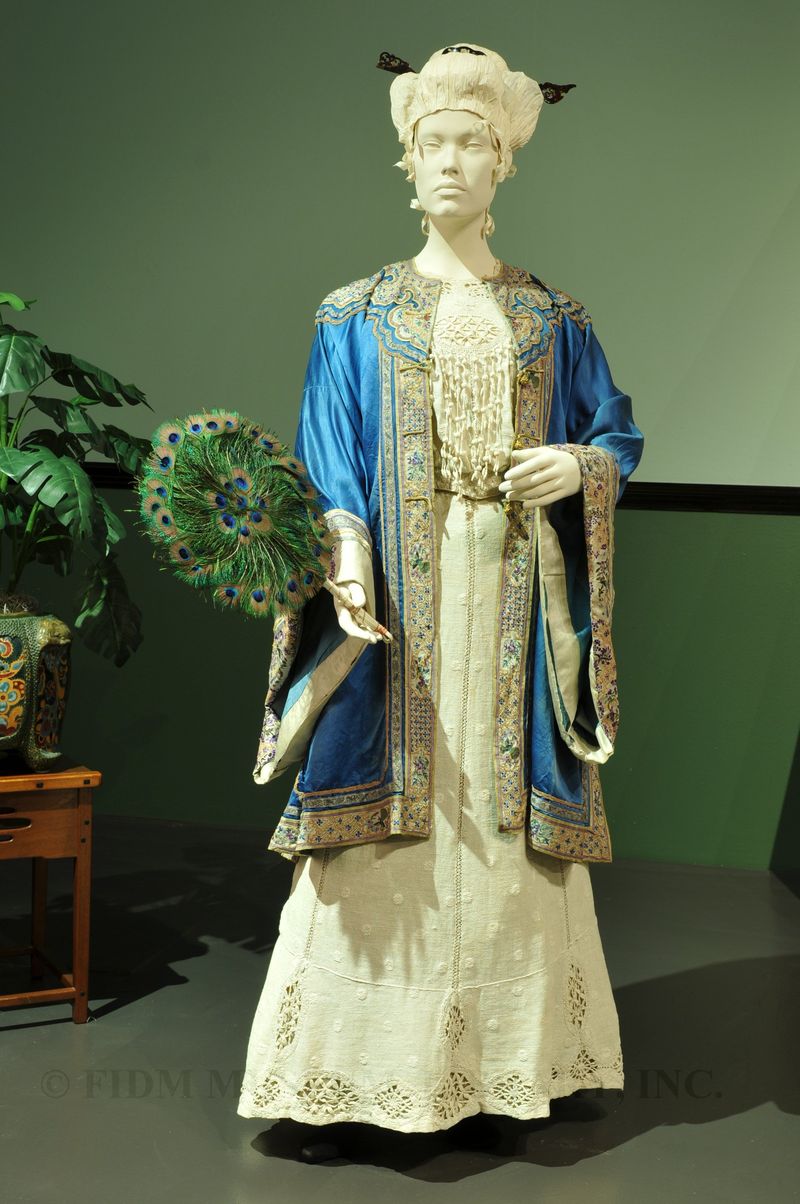While doing some research for an upcoming blog post, I had the chance to revisit images from our 2008 exhibit Aesthetes, Bohemians & Craftsmen: Artistic Dress, 1880s–1920s. Combining fashion, textiles, furniture and ephemera, Aesthetes, Bohemians & Craftsmen followed the path of the design rebellion that occurred in reaction to 19th century industrialization. Originating in mid-19th century England, Artistic dress was sparked by influential artists who subverted societal norms. Rejecting the tightly-trussed clothing of the Victorian era, Artistic dressers sought liberated and individually expressive modes of dressing. Abandoning contemporary fashions, Aesthetes adopted the loose, un-corseted styles of ancient Greece and medieval Europe. In the United States, Bohemian artists championed loose-fitting smocks and the aesthetics of Far Eastern art. Craftsmen looked to the past, creating handmade garments and accessories inspired by historic examples. These groups were unified in their rejection of the inexpensive and widely available products of the Industrial Revolution.
As we hadn't yet established our blog, Facebook profile or Twitter account at the time of this exhibition, most of the installation images from Aesthetes, Bohemians & Craftsmen have never been published. In this post, we share a few images from the exhibit. We hope you enjoy this glimpse into the world of Artistic Dress!
 The first gallery of the exhibition grounded visitors in late 19th century fashionable dress. Straight from Paris, with corseted silhouettes and extreme proportions, these three ensembles are the antithesis of Artistic Dress. Portraits on the opposite wall highlighted the lives and achievements of six Artistic women: Isadora Duncan, Ellen Terry, Romaine Brooks, Baroness Elsa von Freytag-Loringhoven, Annie Garnett and May Morris.
The first gallery of the exhibition grounded visitors in late 19th century fashionable dress. Straight from Paris, with corseted silhouettes and extreme proportions, these three ensembles are the antithesis of Artistic Dress. Portraits on the opposite wall highlighted the lives and achievements of six Artistic women: Isadora Duncan, Ellen Terry, Romaine Brooks, Baroness Elsa von Freytag-Loringhoven, Annie Garnett and May Morris.
 Gallery 2 focused on the Aesthetic movement. Originating in 1880s Britain, the Aesthetic movement rejected modern society, turning instead to earlier historical eras, including classical Greece and Rome and Napoleonic France. This vignette features a c. 1891 day ensemble inspired by the art and dress of the 17th century. Garments with repeating pointed elements like those seen on the hem were often called "Van Dycked" by late 19th century fashion commentators. This name was an allusion to the 17th century Flemish artist Anthony Van Dyck (1599-1641). The boy's ensemble is a c. 1890 black velvet Little Lord Fauntleroy suit. Mariano Fortuny designed the Renaissance inspired textile in the background.
Gallery 2 focused on the Aesthetic movement. Originating in 1880s Britain, the Aesthetic movement rejected modern society, turning instead to earlier historical eras, including classical Greece and Rome and Napoleonic France. This vignette features a c. 1891 day ensemble inspired by the art and dress of the 17th century. Garments with repeating pointed elements like those seen on the hem were often called "Van Dycked" by late 19th century fashion commentators. This name was an allusion to the 17th century Flemish artist Anthony Van Dyck (1599-1641). The boy's ensemble is a c. 1890 black velvet Little Lord Fauntleroy suit. Mariano Fortuny designed the Renaissance inspired textile in the background.
 Gallery 3 explored the world of Bohemia. Often associated with New York's Greenwich Village, Bohemians adopted a variety of non-conforming dress styles: non-Western garments, work or sport clothing, and costumes born of their own imaginations. A highlight of the gallery was this rare c. 1913 Paul Poiret silk tunic. Bridging the worlds of haute couture and Artistic Dress, the tunic demonstrates Poiret's interest in championing unconventional styles. In 1911, Poiret introduced jupes-culottes (trousers) into his collections. This ensemble, featuring a Poiret tunic and reproduction jupes-culottes, would have been worn by only the most Bohemian of dressers.
Gallery 3 explored the world of Bohemia. Often associated with New York's Greenwich Village, Bohemians adopted a variety of non-conforming dress styles: non-Western garments, work or sport clothing, and costumes born of their own imaginations. A highlight of the gallery was this rare c. 1913 Paul Poiret silk tunic. Bridging the worlds of haute couture and Artistic Dress, the tunic demonstrates Poiret's interest in championing unconventional styles. In 1911, Poiret introduced jupes-culottes (trousers) into his collections. This ensemble, featuring a Poiret tunic and reproduction jupes-culottes, would have been worn by only the most Bohemian of dressers.
 Gallery 3 examined the resurgence of traditional crafts that occurred in the wake of the Industrial Revolution. Featuring embroidery, batik, smocking, hand-painting and leather work, this gallery demonstrated how craftspeople revisited and reinterpreted the role of handmade objects in the late 19th and early 20th century. Rejecting luxurious brocades and velvets woven in France, some Artistic dressers began wearing garments made from "honest" homespun textiles. This c. 1905 day dress combines Artistic elements like handcrafted cloth, bobbin lace and hand-knotted fringe with a fashionable silhouette. A late 19th century Chinese short robe and peacock fan demonstrate the ways in which Artistic dressers combined influences and styles in their pursuit of individual integrity in dress.
Gallery 3 examined the resurgence of traditional crafts that occurred in the wake of the Industrial Revolution. Featuring embroidery, batik, smocking, hand-painting and leather work, this gallery demonstrated how craftspeople revisited and reinterpreted the role of handmade objects in the late 19th and early 20th century. Rejecting luxurious brocades and velvets woven in France, some Artistic dressers began wearing garments made from "honest" homespun textiles. This c. 1905 day dress combines Artistic elements like handcrafted cloth, bobbin lace and hand-knotted fringe with a fashionable silhouette. A late 19th century Chinese short robe and peacock fan demonstrate the ways in which Artistic dressers combined influences and styles in their pursuit of individual integrity in dress.


FAbulous!
Yes, fabulous!
Though I’m wondering… do you really say things like “the world of Bohemia” in English? Seeing as Bohemia is primarily a real country (historically determined, now part of the Czech Republic but still present as a way of identification – e.g. “Central Bohemia”), its location to Greenwich Village in your article sounds ridiculous to the Czech me.
Good point. In English, Bohemia has two definitions–the former country/now region, and an artistic free spirit or a community of such people. It also suggests a cultural world that is unattached to a particular geographical point. Though we mention Bohemia in relation to Greenwich Village, that is just one example of a Bohemian world. In English, this is probably the more common usage of the word. This Wikipedia entry helps offers a more detailed explanation of the English usage: http://en.wikipedia.org/wiki/Bohemianism
Did you make a catalogue for this show?
Hi Sophie,
Unfortunately, there was no catalogue for this show. This blog post is your best opportunity to see the exhibit now that it’s over.
Thanks Rachel. Can I ask if you know of a designer called Gaugh? I only have the surname, from a 1916 article referring to artistic dress in Greenwich Village, and can’t drag anything up from Google…
Sophie,
That’s not a name that I’m familiar with. In my research on Greenwich Village, I found that there were many, many small-scale designers working in a variety of media. I suspect they all had relatively modest output and probably sold only from 1 or 2 locations. I’d take a look at the New York Times archive and see if you can find anything; search both the designer’s name and the type of designs they were creating, i.e. batik, embroidery, etc. University libraries and many public libraries have databases (usually Proquest) that include The New York Times. Some Proquest subscriptions also include access to the Vogue archive, which might also be helpful. You might also look into guidebooks to Greenwich Village, which sometimes included the names of popular bohemian shops.
Good luck in your search!